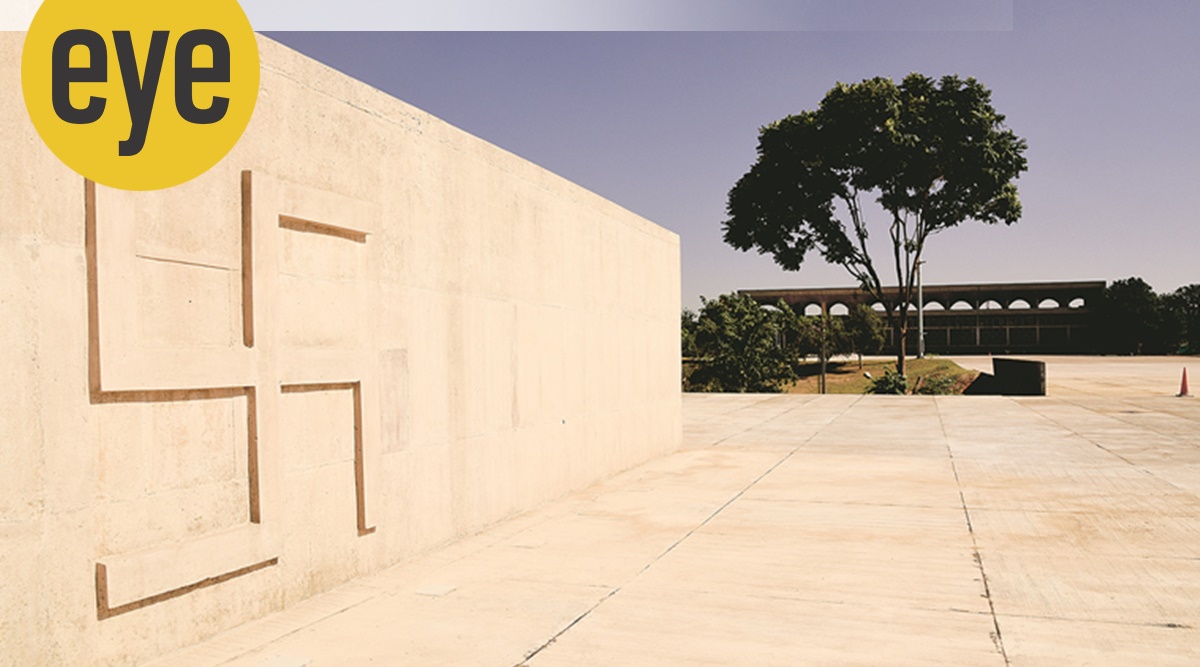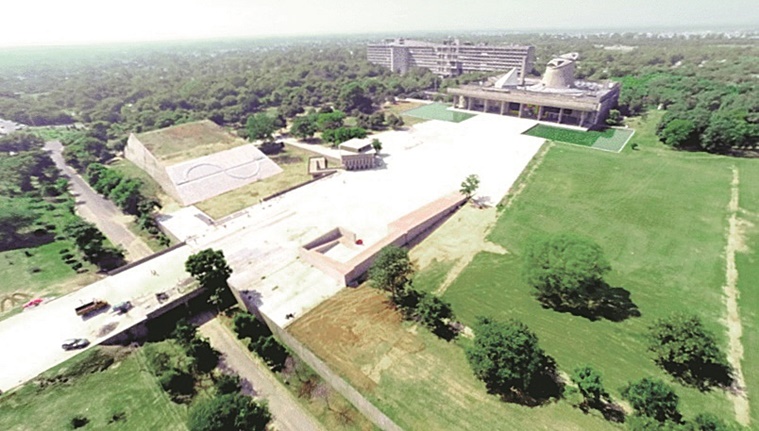 The wall of the Martyrs’ Monument with the symbol of wheel; with the symbol of Swastika. (Photo: Chandigarh administration)
The wall of the Martyrs’ Monument with the symbol of wheel; with the symbol of Swastika. (Photo: Chandigarh administration) Chandigarh was born out of the trauma of India’s Partition. A new city “unfettered by the traditions of the past” was to be created, both to act as the new capital city of Punjab and to settle the vast number of refugees. Though a provincial project, it became a national symbol of India’s new beginning and pride in its resurgent nationhood.
Jawaharlal Nehru, the patron-in-chief of the project, didn’t want any pseudo-revivalist style mimicking the historic monuments of India. So, he invited the iconic modernist Swiss-French planner-architect Le Corbusier to design Chandigarh. Starting on a greenfield panoramic site, Corbusier placed the city’s crowning glory, the Capitol Complex, at the head of the town, with the Shivalik hills in the backdrop. Conceived as a cosmic ensemble of buildings, piazzas, monuments, earth forms and water bodies — placed amidst a pastoral landscape — it was to be detached from the main city, like a later-day Acropolis that echoed the timelessness of Indian civilisation.
The Capitol Complex comprises the assembly, secretariat and high court and the (unbuilt) “governor’s palace”. A vast esplanade between the assembly and the high court was conceived as a pedestrian plaza and was interspersed with monuments, sculptures and symbols. Besides a giant peace sculpture called the Open Hand, there was the Tower of Shadows, Geometric Hill and some other monuments. However, the most enigmatic of all is the Martyrs’ Monument, which remained incomplete. The suggestion to adorn the piazza with signs and symbols, in fact, came from the British architect Jane Drew who, along with her husband Maxwell Fry and Corbusier’s cousin-cum-partner from Paris, Pierre Jeanneret, formed the core of the European team that worked on the Chandigarh project.
One evening, on the lawn of the PWD rest house of Chandigarh, Drew said to Corbusier, “Le Corbusier, you should set up in the heart of the Capitol signs which symbolise the basis of your philosophy and by which you arrived at the basis of your city design. These signs should be known — they are the key to the creation of Chandigarh”.
Corbusier, spurred by Drew’s suggestion, started working on the signs, culling from his sketchbooks . He was equally keen to pick up elements of nature like plants, animals, birds, serpents, etc., as reminders that humans don’t exist in isolation, but in harmony with other living beings. Much before he was chosen for the Chandigarh project, Corbusier was already interested in Indian civilisation, and, in fact, kept a book on it in his office.
 The wall of the Martyrs’ Monument with the symbol of wheel; with the symbol of Swastika. (Photo: Chandigarh administration)
The wall of the Martyrs’ Monument with the symbol of wheel; with the symbol of Swastika. (Photo: Chandigarh administration)
Before installing signs in the Capitol Complex, Corbusier asked Jeanneret for a list of the key symbols denoting Indian civilisation from experts. Not finding much response, Corbusier turned to Nehru, which, too, didn’t yield much. Finally, an Indian junior colleague in Chandigarh gave him a booklet on Indian animal symbols. Eventually, he evolved his own iconography for the Capitol from his collection of sketches of bullock carts, cart wheels and village homes, where humans lived in perfect harmony with domestic animals.
The Martyrs’ Monument is designed as a square enclosure formed by sloping concrete walls and a sculptural ensemble depicting the sacrifice and martyrdom of those who lost their lives during the Partition. The purpose of the ramp in the concrete enclosure is not only to provide a pedestal from which to better observe the sculptural elements of the monument but also to savour the interplay of the various edifices on the plaza.
The Chandigarh administration has recently taken up the completion of this long-awaited project and the missing sculptural components of the monument are now nearing installation. The key elements are a stone debris on which stand a tiger and a serpent alongside a fallen pillar of the colonial edifices. Close to this is a prone human figure, Parusha. The tiger represents strength and the hooded serpent primordial mythological power. The tiger, serpent and the human figure cast in bronze are already completed and wait to be installed on the stone base. It is only the elaborate contours and shape of the fallen column and the debris below the sculptures that are now being made with stone from special quarries in Rajasthan.
 A bird’s eye view of the Capitol Complex showing the Martyrs’ Monument in the centre of the piazza. (Photo: Chandigarh administration)
A bird’s eye view of the Capitol Complex showing the Martyrs’ Monument in the centre of the piazza. (Photo: Chandigarh administration)
On the walls of the ramp and the enclosure are the symbols of Indian cosmology: a wheel and a swastika. The wheel denotes nine planets and the swastika represents the revolution of the sun and the seasons of human life.
The project was conceived by Corbusier in the ’50s. It will be a timely tribute to the victims of the Partition; it will also, 55 years after their creator died, bring to life the sculptures which had been lying around all this while. The monument will also showcase the secular and abstract elements preferred by the patrons of architecture at the time, instead of valorising any individual or ideology.
The completion of the Martyrs’ Monument will also remind the world that Corbusier was a polymath who not only gained fame as an architect-planner but also as a painter, sculptor and colour theorist. He dabbled in the synthesis of geometry and human proportions and relentlessly imbued architecture with an artistic vision that was passionate and insightful.
Rajnish Wattas is an architectural critic and the former principal of the Chandigarh College of Architecture